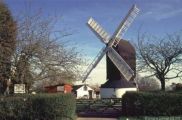
OUTWOOD IN SURREY "The Village with the Mill"
Church History
The history of St John the Baptist, Outwood
In 1859 the village of Outwood was described as a wild outlying district with a population of 542 and no church or school.
Some time about 1860 the Revd John Davis of Nutfield started a weekly Sunday service in Outwood for the benefit of members of the Church of England. Subsequently a benefactor in Nutfield provided a corrugated iron building to be used as a church which it is believed was erected near the current site of the church. In the late 1860s it was decided that a stone church should be built. The foundation stone was laid on 24 May 1869 by the daughter of the Rector of Burstow and consecrated on 23 December 1869 by the Bishop of Winchester. The decision to create the ecclesiastical parish of Outwood was taken by the Ecclesiastical Commissioners for England on 17 August 1870. The new parish of Outwood was created from portions of the parishes of Burstow, Nutfield, Horley, Bletchingley and Horne.
The church was constructed in a plain ‘lancet’ style to a design by the celebrated architect, William Burges, who designed Cardiff Castle. The building comprises a nave of six bays and a chancel with a broad, square tower at the west end. This ‘saddle-back’ tower was added to the church in 1874 by WP Manning and contains, unusually, four bells. The clock was placed in the tower in 1895.
Access to the belfry is via an octagonal turret built into the south east corner of the tower; it does not extend beyond this level. There is a combined clergy and choir vestry adjacent to the north side of the chancel with a catslide roof over. There is an open porch on the south side of the nave.
The exterior of the church is in local Reigate stone and the interior is brick with timbered beams and an acorn shaped strip wood ceiling. The interior brick finish is quite unique and its pointing is an example of Victorian workmanship at its very best.
The church, which is located on the North side of Brickfield Road, a mile or so from the centre of the village, now stands in the middle of National Trust farm, common and woodland.